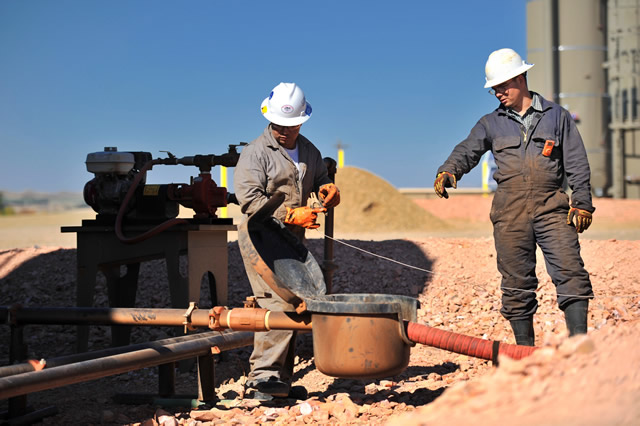Kenny LeBaron, left, and his brother Joshua moved to North Dakota from Minnesota to take advantage of higher salaries due to an oil boom there. Here they service a gas and oil well near Watford City, North Dakota, on September 27, 2011. (Glen Stubbe/Minneapolis Star Tribune/MCT)
As goes Williston, North Dakota, so goes the nation?
That’s probably not a phrase you’ve heard before, but if we opened access to our domestic energy sources, Williston could be the poster child for jumpstarting economic growth in many areas of the country. In fact, the state of North Dakota has been the poster child for what can happen when we unleash free enterprise and allow states to develop and commercialize their resources. North Dakota is drilling at record pace, with oil production doubling from 2008 to 2010.
MSNBC’s Brian Williams showcased Williston and how its economy exploded as a result of hydraulic fracturing and horizontal drilling on his show “Rock Center.” As people from across the country flock to the small North Dakotan town to work on rigs or drive trucks, the demand for housing has skyrocketed as well, creating a boom in both the rental and housing market. As Advertising Age’s E.J. Schultz writes, Williston has become a town “where retailers, restaurants and grocery stores don’t need to advertise to drum up demand. Rather, they fill the local airwaves, newspapers, magazines, and billboards with pleas for workers and promises of unheard-of wages and benefits for normally low-paying small-town service jobs. Where else can you get a $300 signing bonus to work at McDonald’s, or make $14 an hour working the night shift at a gas station?”
As the Institute for Energy Research shows in this infographic, the American inventory of energy spans many states. Improved exploration and production technologies, such as the use of hydraulic fracturing for shale gas extraction, have increased proven reserves in states like Pennsylvania, New York, Texas, Oklahoma, Arkansas, West Virginia, and Louisiana. There is also increasing regional interest in natural gas.
There have been some differences in estimates of recoverable gas, but when you add in the billions of barrels of oil we know exist—in the Western United States and Texas, off the Pacific and Atlantic Coasts, in the Gulf of Mexico, in Alaska’s Arctic National Wildlife Refuge (ANWR), and in the Chukchi Sea off the Alaskan coast—and now you’re starting to talk about an economic game changer.
According to a recent study from energy consultant Wood Mackenzie, allowing access to domestic resources and imports of Canadian oil would generate more than 1 million jobs by 2018 and more than 1.4 million jobs by 2030. The federal government would stand to benefit tremendously as well, collecting more than $36 billion in tax revenue as soon as 2015 and more than $800 billion by 2030.
An aggressive energy policy that opens access, provides a timely permitting process as well as environmental and judicial review, and places a freeze on new environmental regulations from the Environmental Protection Agency (EPA) would go a long way to help lower energy prices, create jobs, and bring revenue into the financially strapped government that’s racked up nearly $15 trillion in debt.
Source material can be found at this site.










